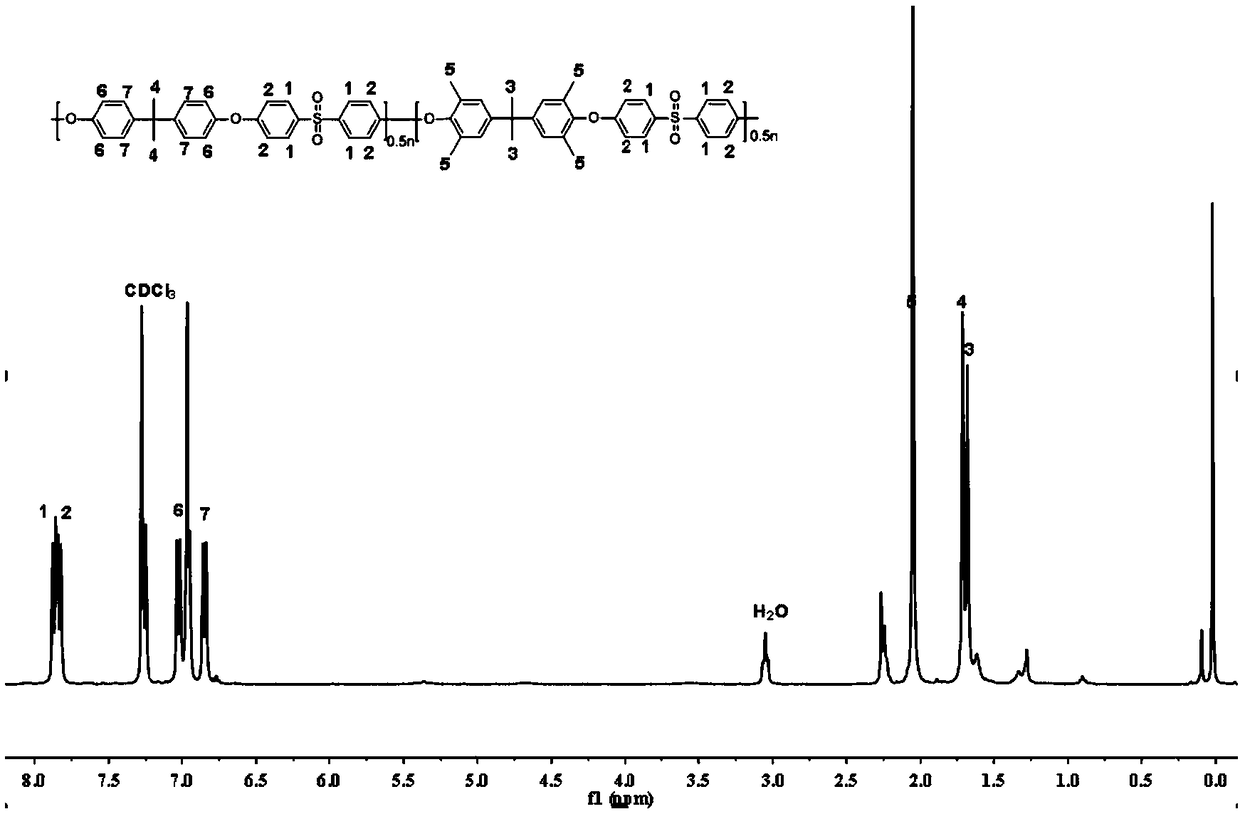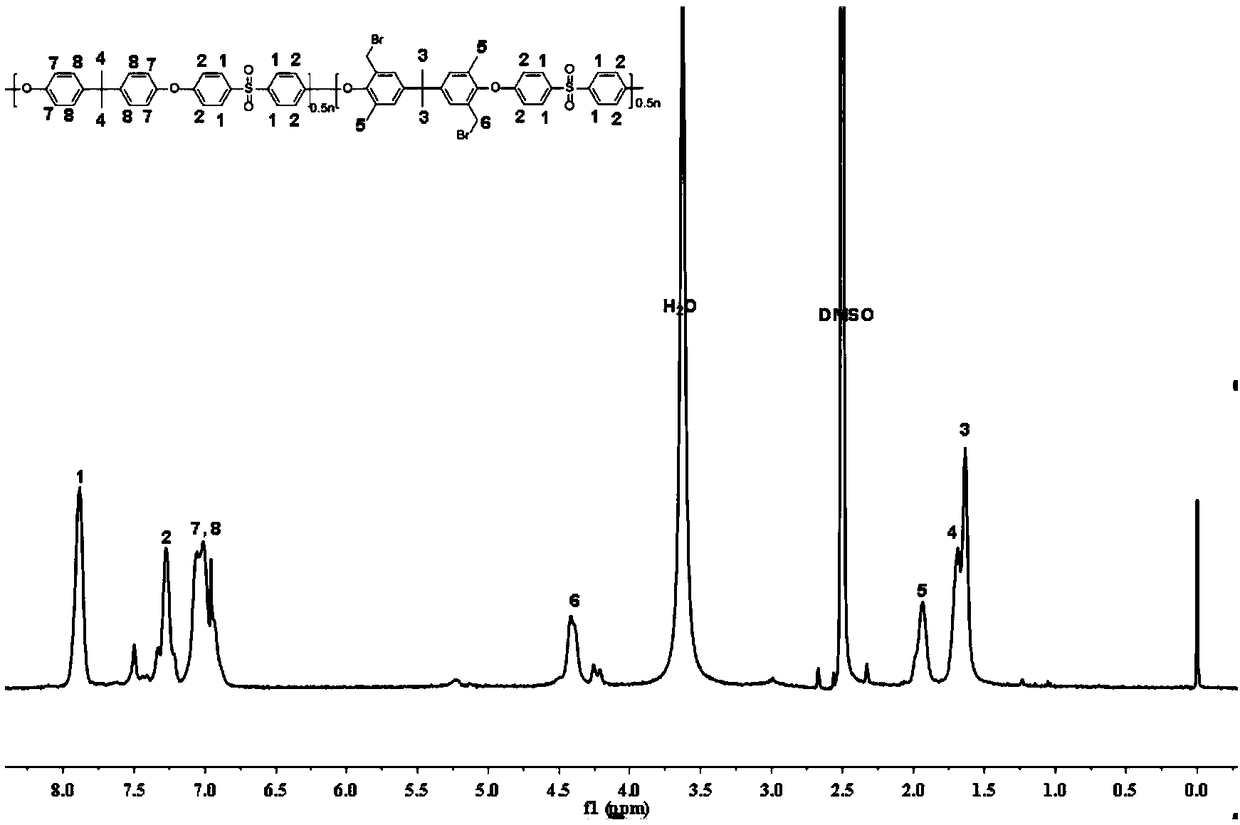A kind of cross-linked basic polyarylether anion exchange membrane and its preparation method and application
An anion-exchange membrane and polyarylether technology, applied in the field of cross-linked polyarylether compounds, can solve the problems of poor alkaline stability and low conductivity
- Summary
- Abstract
- Description
- Claims
- Application Information
AI Technical Summary
Problems solved by technology
Method used
Image
Examples
Embodiment 1
[0114] (1), preparation of random polyarylether compound: 10mmol of tetramethylbisphenol A (formula 19), 1mmol of bisphenol A (formula 22), 11mmol of 4,4'-difluorodiphenyl sulfone (formula 28), add 22mmol of potassium carbonate, 30mL of toluene and 20mL of sulfolane, nitrogen protection, bring water at 140°C for 2h, then raise the temperature to 210°C for 3h, pour the reaction solution into a beaker containing 300mL of methanol and stir to precipitate, And using methanol and deionized water and repeated washing, vacuum drying at 80 ° C to obtain a gray polymer resin, and the structure of the prepared polyarylether compound was characterized by hydrogen nuclear magnetic resonance, as shown in figure 1 As shown, the molecular weight of the prepared random polyarylether compound measured by GPC is 68kg / mol, and the structure is as follows:
[0115]
[0116] (2), bromination: take 0.01mmol of random polyarylether, dissolve it in 20mL of 1,1,2,2,-tetrachloroethane, add 0.035mmol...
Embodiment 2
[0128] (1) Preparation of random polyarylether compounds: 3mmol tetramethylbiquinone (formula 20), 7mmol bisphenol AF (formula 23), 10mmol 4,4'-difluorodiphenyl sulfone (formula 28), Add 20mmol of sodium carbonate, 20mL of toluene and 20mL of N,N-dimethylacetamide, nitrogen protection, bring water at 140°C for 2.5h, then raise the temperature to 165°C for 12h, pour the reaction solution into a container containing 300mL of methanol Stir and precipitate in a beaker, wash with methanol and deionized water repeatedly, and dry under vacuum at 80°C to obtain a gray polymer resin. The molecular weight of the prepared random polyarylether compound is 62kg / mol, and the nuclear magnetic resonance hydrogen Spectra characterized the structure of the prepared polyarylether compound, the structure is as follows:
[0129]
[0130] In the formula, Ar 1 For formula (20), Ar 3 is formula (10)
[0131] (2) Bromination: Take 0.01mmol (0.62g) of random polyarylether, dissolve it in 20mL of ...
Embodiment 3
[0142] (1) Preparation of random polyarylether compounds: 2mmol tetramethylbisphenol fluorene (formula 21), 8mmol p-hydroxycatechol (formula 24), 4,4'-difluorodiphenyl sulfone (10mmol), Add 20mmol of cesium carbonate, 10mL of toluene and 20mL of N,N-dimethylformamide, under nitrogen protection, bring water at 140°C for 3h, then raise the temperature to 150°C for 16h, pour the reaction solution into a tank containing 300mL of methanol Stir and precipitate in a beaker, wash with methanol and deionized water repeatedly, and dry under vacuum at 80°C to obtain a gray polymer resin. The molecular weight of the prepared random polyarylether compound is 52kg / mol, and the hydrogen nuclear magnetic resonance spectrum The structure of the prepared polyarylether compound was characterized, and the structure is as follows:
[0143]
[0144] In the formula, Ar 1 For formula (32), Ar 3 is formula (11)
[0145] (3) Bromination: Take 0.01mmol (0.52g) of random polyarylether, dissolve it ...
PUM
| Property | Measurement | Unit |
|---|---|---|
| thickness | aaaaa | aaaaa |
| tensile strength | aaaaa | aaaaa |
| tensile strength | aaaaa | aaaaa |
Abstract
Description
Claims
Application Information
 Login to View More
Login to View More - R&D
- Intellectual Property
- Life Sciences
- Materials
- Tech Scout
- Unparalleled Data Quality
- Higher Quality Content
- 60% Fewer Hallucinations
Browse by: Latest US Patents, China's latest patents, Technical Efficacy Thesaurus, Application Domain, Technology Topic, Popular Technical Reports.
© 2025 PatSnap. All rights reserved.Legal|Privacy policy|Modern Slavery Act Transparency Statement|Sitemap|About US| Contact US: help@patsnap.com



